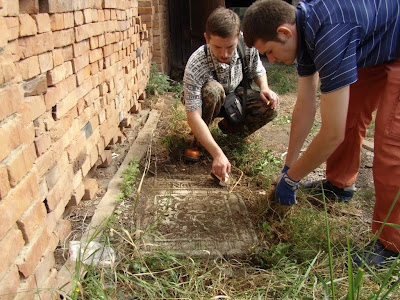
 Sniatyn, Ukraine. (top) Garbage piled in front of Jewish cemetery prior to cleaning and (bottom) cemetery after cleaning: Photo: courtesy Sofia Dyak (July, 2009)
Sniatyn, Ukraine. (top) Garbage piled in front of Jewish cemetery prior to cleaning and (bottom) cemetery after cleaning: Photo: courtesy Sofia Dyak (July, 2009)

Ukraine: Sniatyn Jewish Cemetery Cleaned and Subject of Local Exhibition
by Samuel D. Gruber
(ISJM) Last summer the Center for Urban History in East Central Europe in Lviv organized a student project called "Sniatyn- Archeology of Memory: Discovering and Reviving the Historical Heritage of Galician Town." The project was created within the framework of the program "Memoria", initiated by the foundation "Memory, Responsibility and Future" together with the Stefan Batory Foundation. The southern Galician town of Sniatyn was chosen for the project as an example of a border city. It is located near Bukovina (now Ukraine, Moldova and Romania), an area of rich multi-cultural history, where Ottoman, Austiran and Polish-Ukrainian cultures intermingled. According to researchers from the Center, “statistics from the first half of the 20th century suggest that close to two fifths of the population was formed by Ukrainians (Ruthenians), more than a third were Jews, and one fifth was made up of Poles. Other than these three main groups, there was also a small number of Germans, Armenians and Czechs.” Bukovina was also home to an especially fine tradition of Jewish cemetery art, which can still be seen at many extant sites, but is also remembered in photographs of now-lost carved matzevot (gravestones).
Thanks to project coordinator Sofia Dyak, I am posting photographs from the camp – which was organized as a two-week as a history and conservation seminar, illustrating some of the work done. (It I now snowing out my window, so I savor these summer photos – and hope that the organizers will sponsor similar events and opportunities in 2010).
 Sniatyn, Ukraine. Jewish cemetery, cleaned matzevah, presumably - because of the pitcher - of a Levite.
Sniatyn, Ukraine. Jewish cemetery, cleaned matzevah, presumably - because of the pitcher - of a Levite.
Photo: courtesy of Sofia Dyak (2009)
According to Dyak, “the goal of the project was to return the attention of the inhabitants of Sniatyn to the multi-national and multi-religious heritage of their city with the help of the two week program of a volunteer camp made up of youth from Ukraine, Poland and Germany” Most of the 19 participants were students from the Institute of Architecture in Lviv. The group studied and worked on conservation projects on the adjacent Jewish and Christian cemeteries and learned more about the heritage of the region, but also the contemporary life of Sniatyn. The Christian cemetery is still in use, but since the destruction of the local Jewish community in the Holocaust, the Jewish cemetery was abandoned and neglected; many gravestones had been robbed, and those still in situ were endangered by spreading tree root and excess vegetation.
Students cleaned the cemeteries and also discovered Jewish gravestones paving a courtyard. During and after the Second World War Jewish gravestones were frequently used for paving (see for examples, the polychrome matzevot recently discovered in Radom, Poland. Other examples are known from Kazimierz Dolny, where they were retrieved and erected into a monument, and from Kremenets, Ukraine).
The project also arranged for translation of about 80 inscriptions from the Jewish cemetery. This inscriptions, as well as study of symbolic imagery used on the stones was of great interest to the students, and was also used as tool to engage wider local interest in the history and care of the site.
The two-session culminated in the presentation of an outdoor exhibition on the main city square displaying the results of volunteers’ work to engage and inform the local inhabitants. Dr. Khrystyna Boyko (National University "Lviv Polytechnic") was the academic leader of the project.
For more information click here.






2 comments:
Thank you so much for posting this. I've been following the project since its planning stages and it was wonderful to read and see its culmination phase.
S. Kulick
Manhattan
the tombstone in the first picture is from אברהם אליעזר ב"ר יוסף דוד סג"ל
Abraham Eliezer son of Yoseph David Sg"l (Leviate)
Post a Comment